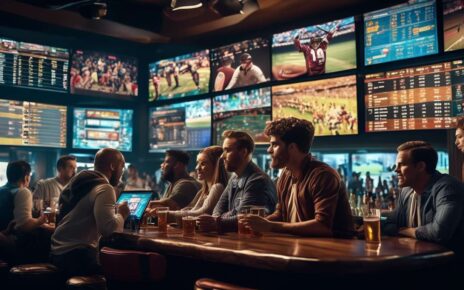Betting Odds Explained: 10 Quick Facts
As avid sports enthusiasts and curious minds, we often find ourselves drawn to the intriguing world of betting odds. These numbers, often surrounded by a veil of mystery, hold the potential to turn a simple game into a captivating experience.
We know that navigating the complex landscape of betting can be daunting, especially for those who are new to the concept. That’s why we’re here to break it down into digestible pieces. In this article, "Betting Odds Explained: 10 Quick Facts," we’ll unravel the secrets behind these figures and provide you with a clearer understanding.
Key Areas of Focus:
-
Understanding What Odds Represent:
- Odds indicate the probability of an event occurring.
- They also reflect the potential payout if the bet is successful.
-
How Odds Are Calculated:
- Bookmakers use statistical models and historical data.
- Odds are adjusted based on betting volume and market trends.
-
Different Formats of Odds:
- Decimal Odds: Common in Europe, simple to understand.
- Fractional Odds: Traditional format in the UK.
- Moneyline Odds: Popular in the United States.
By exploring what odds truly represent, how they’re calculated, and the different formats they come in, we’ll equip ourselves with the knowledge needed to make informed decisions.
Whether we’re placing a friendly wager among friends or considering a more strategic bet, understanding odds is the first step in mastering the art of sports betting.
Probability and Payout
Understanding probability and payout is essential for anyone interested in betting odds. We know that feeling of wanting to dive into the betting world, to feel like we’re part of something bigger. So, let’s break down the basics together.
Probability is the heart of betting; it tells us how likely an event is to happen. Odds, on the other hand, are the numbers that represent that probability. When we look at odds, we’re essentially seeing the bookmaker’s estimation of an event’s chance of occurring.
Betting isn’t just about guessing; it’s about understanding these numbers. If we get the odds right, we can determine potential payouts, which is the reward for our risk.
- For instance, higher odds often mean a bigger payout, but they also indicate a lower probability of winning.
By grasping these concepts, we can make more informed decisions and share in the excitement and camaraderie of betting with confidence.
Statistical Modeling in Calculations
Statistical modeling gives us a powerful tool to analyze and predict betting outcomes with greater accuracy. By leveraging probability, we can transform raw data into insights that increase our chances of making informed bets. This approach enhances our understanding and decision-making in the betting arena.
When we embrace statistical modeling, we’re not just guessing; we’re calculating. It allows us to:
- Assess the likelihood of different outcomes.
- Craft strategies that align with our betting goals.
By modeling probabilities, we can:
- Determine which odds offer the best value.
- Identify potential opportunities others might overlook.
In our community, sharing insights from statistical models fosters a sense of belonging and collective wisdom. We’re not alone in this journey; we’re part of a network that values data-driven decisions.
As we delve deeper into statistical modeling, we not only enhance our betting strategies but also strengthen our connection with fellow enthusiasts who appreciate the power of numbers.
Impact of Betting Volume
A significant factor we must consider is how the volume of bets can influence both market dynamics and odds fluctuations.
When we engage in betting, we’re not just spectators; our collective actions shape the landscape. High betting volume can lead to odds adjustments as bookmakers strive to balance their books. This dynamic interaction impacts the perceived probability of an event occurring.
- When more bets are placed on a particular outcome, the odds may shorten, signaling increased confidence in that outcome.
- Conversely, if an outcome attracts fewer bets, the odds may lengthen, indicating lower probability.
We’re part of a community that directly affects how odds are set and adjusted. The beauty of this lies in our shared ability to interpret these odds, understanding that they reflect our collective betting behavior.
By participating, we contribute to the ebb and flow of probabilities, making each wager a small yet significant part of a larger narrative in the betting world.
Market Trends Adjustment
In a rapidly evolving betting landscape, it is crucial to stay attuned to market trends that adjust in response to changes in public sentiment and external factors. As a community of bettors, understanding these shifts helps us make informed decisions.
When probability is affected by factors such as:
- News events
- Injuries
- Shifts in team dynamics
Odds can change rapidly. We find camaraderie in recognizing these patterns and adjusting our strategies accordingly.
Odds reflect the probability of an event occurring, and staying updated on how these probabilities change is essential. Our collective insights can guide us more effectively in predicting outcomes. By sharing observations and discussing trends, we strengthen our betting strategies and enhance our chances of success.
Whether we are seasoned bettors or newcomers, the key is to remain flexible and open to new information. Together, we navigate the complexities of betting markets, always ready to adapt.
In doing so, we not only increase our chances of winning but also foster a sense of belonging within our betting community.
Understanding Decimal Odds
Decimal odds provide a straightforward way to calculate potential returns on bets and are particularly popular in Europe and Australia. They are simple to understand, helping bettors feel more connected to a community that shares their passion.
How Decimal Odds Work:
-
Decimal odds display the total amount we’ll receive for every unit we bet, including our original stake.
-
For example, with odds of 2.50:
- Multiply your stake by 2.50 to calculate your total return.
- A $10 bet would return $25, which includes both your stake and profit.
Calculating Implied Probability:
- Divide 1 by the decimal odds.
- Multiply the result by 100.
- For odds of 2.50, the probability calculation would be:
- ( \frac{1}{2.50} \times 100 = 40\% )
Understanding the implied probability helps gauge the risk and potential reward, enabling informed betting choices within the community.
Deciphering Fractional Odds
Fractional Odds Overview
Fractional odds are popular in the UK and offer a distinct perspective on potential betting returns. They are expressed as two numbers separated by a slash, such as 5/1.
Understanding Fractional Odds
-
Format: The first number represents the profit you can make, while the second number indicates the amount you need to stake.
-
Example: With 5/1 odds, you will earn five units of profit for every one unit you wager.
Probability Calculation
Fractional odds also provide insight into the likelihood of an event occurring. To calculate the probability:
- Divide the second number by the sum of both numbers.
- For example, 5/1 odds convert to a probability of 1/(5+1), or roughly 16.67%.
Community and Decision Making
Understanding these odds enhances our shared interest in betting and aids in making informed decisions. Embracing the unique charm of fractional odds can lead to better engagement and strategy in the betting community.
Navigating Moneyline Odds
Moneyline Odds Overview
Moneyline odds are a common format in the US that simplify the betting process by focusing on the amount won relative to a $100 wager. Understanding this can help bettors feel more connected and confident when placing their bets.
How Moneyline Odds Work
Positive Odds:
- Example: +150
- A $100 bet could yield $150 in profit.
Negative Odds:
- Example: -200
- You’d need to wager $200 to win $100.
Interpreting Moneyline Odds
- Positive Odds: Higher positive odds suggest a less likely event.
- Negative Odds: Lower negative odds indicate a more probable outcome.
Importance of Understanding Moneyline Odds
By mastering moneyline odds, bettors can:
- Align themselves with a knowledgeable betting community.
- Enhance shared experiences.
- Increase their chances of success.
Understanding these odds is crucial as they reflect the implied probability of an event occurring, allowing bettors to make informed decisions.
Making Informed Betting Decisions
To make informed betting decisions, we must evaluate various factors that impact the outcome of an event. Understanding probability is key. By analyzing the likelihood of different outcomes, we can assess which side of the odds offers the best value.
Interpreting Odds:
- Understand Potential Returns: Odds indicate the potential returns on a bet.
- Implied Probability: Odds also reflect the implied probability of an event occurring.
It’s essential to compare these implied probabilities with our own assessments. If we perceive a higher probability than the odds suggest, that’s where we might find value in betting.
Staying Informed:
- Stay updated with current information, like team performance and player conditions.
- Engage in discussions with fellow bettors to gain additional insights.
Together, we can build a community where knowledge is shared, and informed decisions become second nature.
Let’s make smarter bets, together.
How do legal regulations affect betting odds across different regions?
Legal regulations have a significant impact on betting odds in various regions.
They dictate several key aspects of betting:
- What types of bets are allowed
- How odds are calculated
- Which sports can be wagered on
These regulations aim to ensure:
- Fairness
- Transparency
- Responsible gambling practices
Understanding the laws in your area is crucial to:
- Make informed betting decisions
- Stay compliant with the rules in place
By being aware of these legal frameworks, bettors can engage more responsibly and avoid potential legal issues.
What are the psychological factors that influence a bettor’s decision-making process?
Psychological Factors in Betting
When making betting choices, psychological factors play a crucial role. Emotions such as:
- Excitement
- Fear
- Overconfidence
can sway our decisions.
Cognitive Biases
Cognitive biases also impact how we assess risks and rewards. Some common biases include:
- Confirmation Bias
- Gambler’s Fallacy
Understanding these influences can help us make more rational and informed bets.
Improving Decision-Making
By recognizing our tendencies, we can strive to improve our decision-making process. This awareness can potentially increase our chances of success.
How do bookmakers set initial odds for a sporting event?
Setting Initial Odds for a Sporting Event
We set initial odds by analyzing various factors to ensure they are balanced and reflective of true probabilities. Key factors include:
- Team performance
- Player injuries
- Historical data
- Public sentiment
Objective
Our goal is to create a balanced line that attracts bets from both sides. This helps ensure that our odds are both competitive and accurate.
Continuous Monitoring and Adjustment
By constantly monitoring and adjusting our odds, we aim to:
- Minimize risk
- Maximize profitability for our sportsbook
This dynamic approach helps us maintain a competitive edge in the market.
Conclusion
Now that you’ve grasped the basics of betting odds, you’re well-equipped to make informed decisions in the exciting world of betting.
Key Concepts to Remember:
-
Understanding Probability: This is crucial as it helps you assess the likelihood of different outcomes and make smarter bets.
-
Statistical Modeling: Utilizing data and statistics can enhance your ability to predict outcomes more accurately.
-
Market Trends: Keeping an eye on trends can provide valuable insights that influence your betting strategy.
Types of Odds:
- Decimal Odds: Easy to understand and commonly used in Europe, these odds show the total payout rather than just the profit.
- Fractional Odds: Predominantly used in the UK, these odds indicate the profit relative to the stake.
- Moneyline Odds: Popular in the US, these odds reflect how much you need to stake or how much you will win on a $100 bet.
You now have the knowledge to navigate these odds confidently. So go ahead, put your newfound expertise to the test, and enjoy the thrill of strategic betting.
Good luck!




